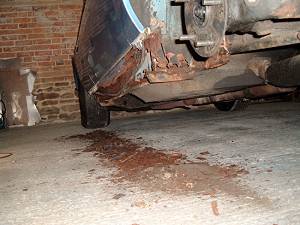 |
The Aston Martin V8 is fitted with stainless steel sill covers which have two functions: The first is to collect mud to encourage rust, and the second is to hide that rust from view until it's too late. I removed the LHS sill covers and enough mud and rust fell from the sills to fill a bucket. |
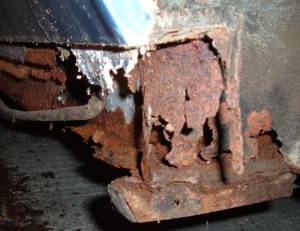 |
The structure of the sills is nearly shown in this photograph taken from the rear wheelarch looking forward. The main strength of the sill is in a rectangular box section, the remains of which are clearly visible in the photograph. An outer sill (mostly missing) was welded to the outside of this box section to act as a mounting point for the front and rear wings. The square section tube below the sill is the mounting point for the optional outrigger ski. |
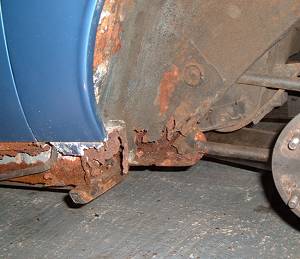 |
Rust has also spread into the rear suspension lower trailing arm mounting which will have to be completely replaced. The chassis member will need repairs, but the upper suspension arm mounting seems to have remained largely intact. |
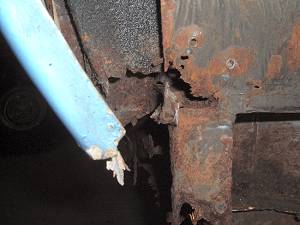 |
The B-pillar has almost completely detached from the sill (photograph taken from rear suspension looking forward). Where it is still attached the rust has pushed the pillar outwards by around 1/8 inch causing door alignment problems. The A-pillar (door hinge pillar) is also corroded, but not quite so badly. The alignment will be corrected using a simple body jig before the new sills are welded on. |
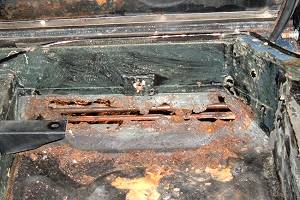 |
The sills are just as bad on the other side of the car where there is also a large hole in the rear floor. The rust was caused by mud trapped on top of a cover plate for the fuel pipes which are visible through the hole. |
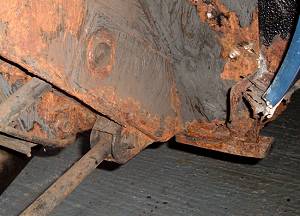 |
The suspension mounting and chassis on the right hand side of the car have not deteriorated as badly as those on the left side. Even so, it is possible that many of the same repairs will be necessary as on the other side of the car. There is a line of rust on the bottom of the inner wheelarch panel (where the lower suspension arm mounting is attached to the chassis). This is caused by a rolled edge on the bottom of the inner wheelarch which fills with mud and rots away. |
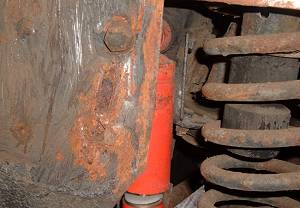 |
There is also some rust in the rear damper mounting. This mounting is constructed from multiple skins of steel and is rusting from the inside. Double skins of steel are a common cause of rust in old cars. No matter how well they are sealed, water will always find it's way between the skins which will stay damp and rot. I try to replace double skins with thicker single skins wherever possible. |
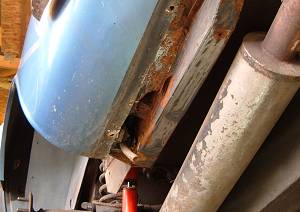 |
Moving rearwards, the mounting flange for the rear wings has rusted away. This section is normally hidden under the GRP panels that cover the rear corners of the car. |
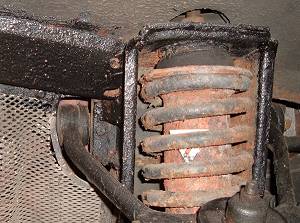 |
The front of the car hasn't rusted as badly as the rear, although the upper chassis member has corroded where it meets the front suspension tower. The rust holes are visible in the photograph as small brown patches on the black painted chassis member just to the left of the spring and damper tower. |
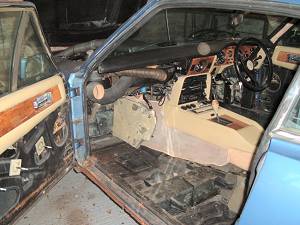 |
The interior has been partially stripped to prevent damage during sill replacement. Aston Martin are pretty devious when it comes to interior trim. The mounting screws were very well hidden. I wasn't planning to remove quite so much of the dashboard, but a surprising amount had to be removed to access a small screw at the top of the A-pillar trim panel. |
| I found some more production engineering fun on the car. My favorite is the wiring loom that runs along the RHS sill. My hopes were raised by some handy wiring connectors just before the wiring goes into the sill, but the connectors were too big to fit through the hole. Instead the wiring needed to be disconnected from every single electrical device in the rear of the car, and the mass of wiring fed forward through the sills to the dash area. There are some other bits of rust on the car which I haven't covered here as I don't have good access for photographs - there are holes where the rear wings join the boot floor, and on the rear face of the Watts Linkage mountings. I'll add further photographs as I strip the car. The Aston Workshop has photographs of many different types of Aston Martins undergoing restoration which I have found useful. Next: B Pillar and rear chassis welding Back to: Aston Martin Restoration |
|